Risk and Health Behaviors(问卷)
- 格式:pdf
- 大小:240.74 KB
- 文档页数:55
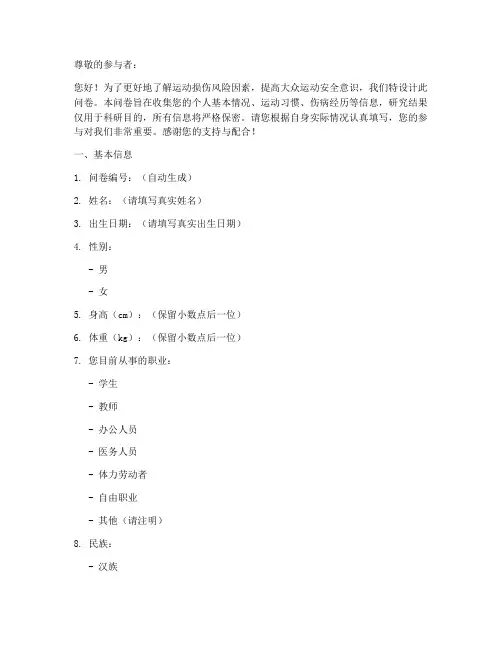
尊敬的参与者:您好!为了更好地了解运动损伤风险因素,提高大众运动安全意识,我们特设计此问卷。
本问卷旨在收集您的个人基本情况、运动习惯、伤病经历等信息,研究结果仅用于科研目的,所有信息将严格保密。
请您根据自身实际情况认真填写,您的参与对我们非常重要。
感谢您的支持与配合!一、基本信息1. 问卷编号:(自动生成)2. 姓名:(请填写真实姓名)3. 出生日期:(请填写真实出生日期)4. 性别:- 男- 女5. 身高(cm):(保留小数点后一位)6. 体重(kg):(保留小数点后一位)7. 您目前从事的职业:- 学生- 教师- 办公人员- 医务人员- 体力劳动者- 自由职业- 其他(请注明)8. 民族:- 汉族- 少数民族(请注明)9. 居住地:(请填写详细地址)二、运动习惯10. 过去一年有无运动习惯?- 有- 无11. 您参加运动的目的或者动因是: - 健身减肥- 提高体质- 缓解压力- 娱乐休闲- 其他(请注明)12. 习惯每天运动的时段:- 早上- 中午- 晚上- 清晨13. 是否正规学习过运动项目的动作? - 是- 否14. 是否有过专门的力量训练?- 是- 否15. 进行何种形式的力量训练【多选题】 - 器械练习- 自由负重- 自身体重16. 力量训练期间有无专业人员指导?- 一直有- 经常有- 偶尔有- 从来没有17. 是否进行其它形式的运动?- 是,其它运动具体包括:(请注明) - 否18. 每次运动前是否进行充分热身?- 经常进行- 有时候热身- 偶尔热身- 不热身19. 每次运动后是否进行彻底放松?- 经常进行- 有时候放松三、伤病经历20. 您是否有以下伤病经历?- 骨折- 软组织损伤- 关节炎- 其他(请注明)21. 您的伤病发生时间:- 一年内- 一至三年前- 三年以上22. 您的伤病恢复情况:- 已完全恢复- 部分恢复- 未恢复四、其他23. 您认为以下哪些因素可能增加运动损伤风险?- 运动环境- 运动装备- 运动动作- 运动强度- 其他(请注明)24. 您对运动损伤预防措施有何建议?- (请注明)感谢您参与本次问卷调查!祝您身体健康,运动愉快!。
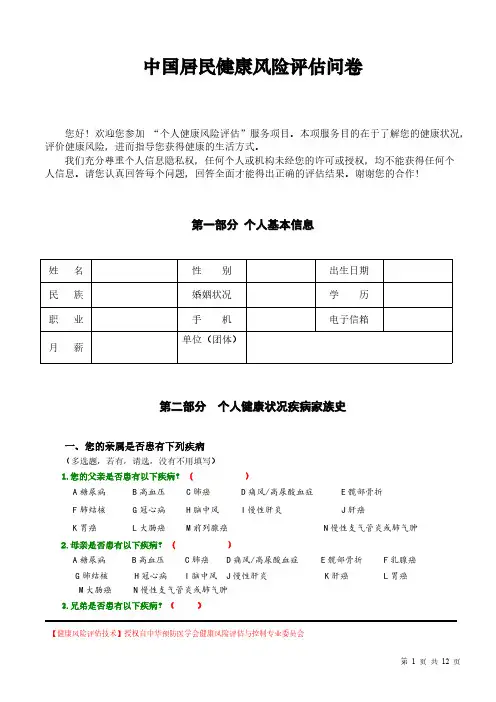
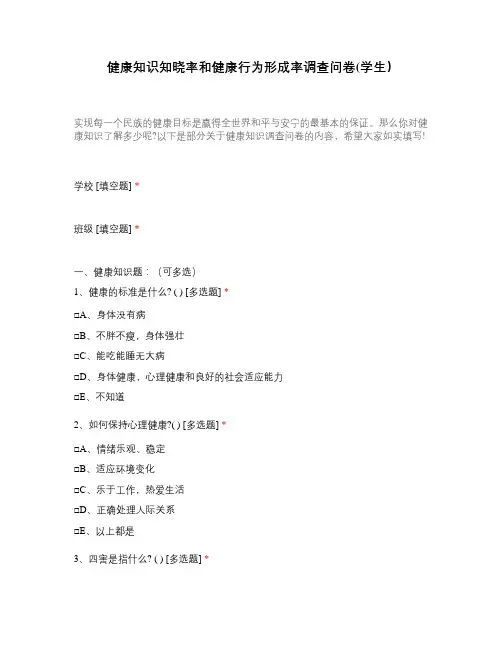
健康知识知晓率和健康行为形成率调查问卷(学生)实现每一个民族的健康目标是赢得全世界和平与安宁的最基本的保证。
那么你对健康知识了解多少呢?以下是部分关于健康知识调查问卷的内容,希望大家如实填写!学校 [填空题] *_________________________________班级 [填空题] *_________________________________一、健康知识题:(可多选)1、健康的标准是什么? ( ) [多选题] *□A、身体没有病□B、不胖不瘦,身体强壮□C、能吃能睡无大病□D、身体健康,心理健康和良好的社会适应能力□E、不知道2、如何保持心理健康?( ) [多选题] *□A、情绪乐观、稳定□B、适应环境变化□C、乐于工作,热爱生活□D、正确处理人际关系□E、以上都是3、四害是指什么? ( ) [多选题] *□A、老鼠□B、蚊子□C、苍蝇和蟑螂□D、以上都是4、饮食卫生主要包括哪几个方面?( ) [多选题] *□A、一日三餐,定时定量□B、不挑食和不偏食□C、少吃或不吃零食□D、饭前便后要洗手□E、预防食物中毒。
□F、以上都是5、预防痤疮的主要方法:( ) [多选题] *□A、注意皮肤卫生,每天用温水洗脸,不要用含油性的香脂和化妆品; □B、少吃脂肪,糖类和刺激性食物;□C、生痤疮后不要用手挤压,尤其不要挤压鼻周围的痤疮;□D、以上都是6、中小学生心理健康有哪些主要指标?( ) [多选题] *□A、学习态度积极□B、人际关系比较和谐□C、情绪愉快稳定□D、适应周围环境的变化□E、有一定的自我调节能力□F、符合中学生的心理特点□G、以上都是7、中小学生如何做好心理保健?( ) [多选题] *□A、树立积极、正确的人生观□B、培养交往能力,建立良好的人际关系□C、积极参加集体活动、培养集体主义精神□D、培养和发展对自己有益的兴趣和爱好□E、磨练自己的意志,提高自我调控能力□F、掌握一些心理保健的具体方法,如发泄、倾诉、转移、自我暗示等□H、以上都是8、怎样预防近视眼?( ) [多选题] *□A、改善视觉环境:注意用眼卫生,看书写字要姿势正确;坚持做眼保健操;课桌椅和采光照明条件均符合科学要求;□B、保证每天1小时体育活动和充足的睡眠;□C、常吃动物肝脏和胡萝卜;□D、每年至少检查视力2次,发现视力减退应及时诊治。
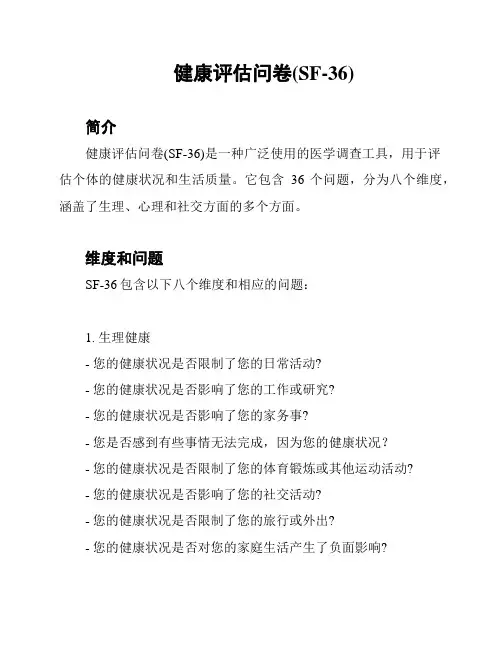
健康评估问卷(SF-36)简介健康评估问卷(SF-36)是一种广泛使用的医学调查工具,用于评估个体的健康状况和生活质量。
它包含36个问题,分为八个维度,涵盖了生理、心理和社交方面的多个方面。
维度和问题SF-36包含以下八个维度和相应的问题:1. 生理健康- 您的健康状况是否限制了您的日常活动?- 您的健康状况是否影响了您的工作或研究?- 您的健康状况是否影响了您的家务事?- 您是否感到有些事情无法完成,因为您的健康状况?- 您的健康状况是否限制了您的体育锻炼或其他运动活动?- 您的健康状况是否影响了您的社交活动?- 您的健康状况是否限制了您的旅行或外出?- 您的健康状况是否对您的家庭生活产生了负面影响?2. 生活质量- 您对自己的整体健康感到满意吗?- 您感到身体的疼痛吗?- 您感到精力充沛吗?- 您感到情绪焦虑吗?- 您感到情绪疲劳吗?- 您感到情绪沮丧吗?- 您感到情绪愉快吗?- 您感到生活充实吗?3. 身体功能- 您感到身体活动受限吗?- 您感到身体活动不便吗?- 您感到需要帮助才能完成某些活动吗?- 您感到需要使用辅助设备才能完成某些活动吗?4. 身体疼痛- 您是否有身体疼痛的感觉?- 您感到身体疼痛的程度如何?- 您的身体疼痛是否影响了您的日常活动?5. 一般健康感觉- 您对自己的整体健康感觉满意吗?- 您感到身体活动受限吗?- 您感到有些事情无法完成,因为您的健康状况?6. 生活能力- 您感到生活方面的限制吗?- 您感到生活各个领域的限制程度如何?7. 社交功能- 您感到社交活动受限吗?- 您感到社交活动不便吗?8. 情绪健康- 您感到情绪不稳定吗?- 您感到情绪疲劳吗?- 您感到情绪紧张吗?使用注意事项- 请如实回答每个问题,以便获取准确的健康评估结果。
- 评估结果将帮助医生和研究人员了解您的健康状况和生活质量,并为您提供相应的医疗建议。
- SF-36是一种标准化的问卷,已被广泛验证和采用,因此可以有效比较和分析不同群体的健康状况。
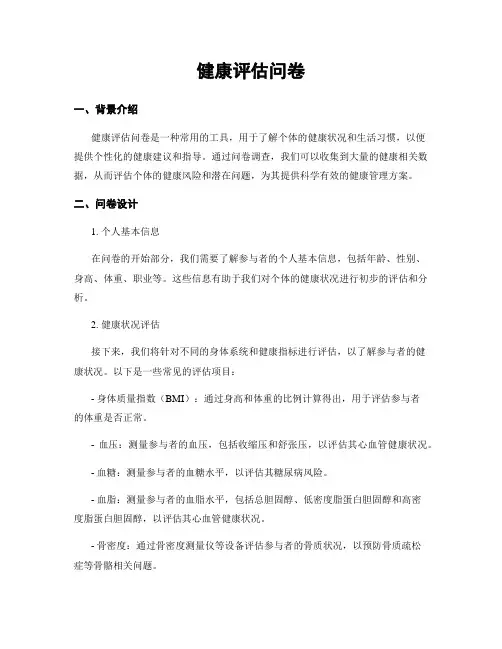
健康评估问卷一、背景介绍健康评估问卷是一种常用的工具,用于了解个体的健康状况和生活习惯,以便提供个性化的健康建议和指导。
通过问卷调查,我们可以收集到大量的健康相关数据,从而评估个体的健康风险和潜在问题,为其提供科学有效的健康管理方案。
二、问卷设计1. 个人基本信息在问卷的开始部分,我们需要了解参与者的个人基本信息,包括年龄、性别、身高、体重、职业等。
这些信息有助于我们对个体的健康状况进行初步的评估和分析。
2. 健康状况评估接下来,我们将针对不同的身体系统和健康指标进行评估,以了解参与者的健康状况。
以下是一些常见的评估项目:- 身体质量指数(BMI):通过身高和体重的比例计算得出,用于评估参与者的体重是否正常。
- 血压:测量参与者的血压,包括收缩压和舒张压,以评估其心血管健康状况。
- 血糖:测量参与者的血糖水平,以评估其糖尿病风险。
- 血脂:测量参与者的血脂水平,包括总胆固醇、低密度脂蛋白胆固醇和高密度脂蛋白胆固醇,以评估其心血管健康状况。
- 骨密度:通过骨密度测量仪等设备评估参与者的骨质状况,以预防骨质疏松症等骨骼相关问题。
- 睡眠质量:通过问卷或睡眠监测设备评估参与者的睡眠质量,以了解其睡眠是否充足和是否存在睡眠障碍。
3. 生活习惯和行为评估除了身体健康状况,我们还需要了解参与者的生活习惯和行为,因为这些因素对健康有重要影响。
以下是一些常见的评估项目:- 饮食习惯:了解参与者的饮食结构、吃饭时间和摄入的营养素种类和量,以评估其饮食是否均衡健康。
- 运动习惯:了解参与者的运动频率、运动方式和运动强度,以评估其体育锻炼情况。
- 吸烟和饮酒情况:了解参与者的吸烟和饮酒习惯,以评估其对健康的影响。
- 压力水平:通过问卷评估参与者的压力水平,以了解其心理健康状况。
三、数据分析和结果呈现收集到的问卷数据将进行统计分析和处理,以得出参与者的健康评估结果。
我们将根据参与者的个人信息、健康状况评估和生活习惯评估的结果,综合分析其健康风险和潜在问题,并给出相应的健康建议和指导。
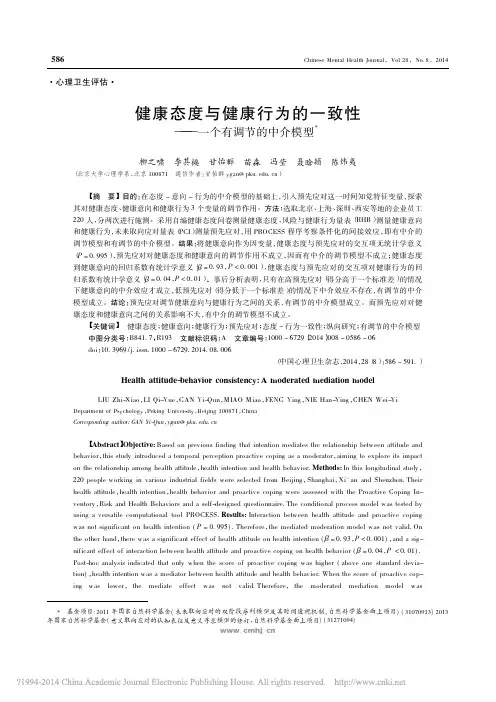
·心理卫生评估·健康态度与健康行为的一致性———一个有调节的中介模型*柳之啸李其樾甘怡群苗淼冯莹聂晗颖陈炜夷(北京大学心理学系,北京100871通信作者:甘怡群ygan@)【摘要】目的:在态度-意向-行为的中介模型的基础上,引入预先应对这一时间知觉特征变量,探索其对健康态度、健康意向和健康行为3个变量的调节作用。
方法:选取北京、上海、深圳、西安等地的企业员工220人,分两次进行施测。
采用自编健康态度问卷测量健康态度,风险与健康行为量表(RHB)测量健康意向和健康行为,未来取向应对量表(PCI)测量预先应对,用PROCESS程序考察条件化的间接效应,即有中介的调节模型和有调节的中介模型。
结果:将健康意向作为因变量,健康态度与预先应对的交互项无统计学意义(P=0.995),预先应对对健康态度和健康意向的调节作用不成立,因而有中介的调节模型不成立;健康态度到健康意向的回归系数有统计学意义(β=0.93,P<0.001),健康态度与预先应对的交互项对健康行为的回归系数有统计学意义(β=0.04,P<0.01)。
事后分析表明,只有在高预先应对(得分高于一个标准差)的情况下健康意向的中介效应才成立,低预先应对(得分低于一个标准差)的情况下中介效应不存在,有调节的中介模型成立。
结论:预先应对调节健康意向与健康行为之间的关系,有调节的中介模型成立。
而预先应对对健康态度和健康意向之间的关系影响不大,有中介的调节模型不成立。
【关键词】健康态度;健康意向;健康行为;预先应对;态度-行为一致性;纵向研究;有调节的中介模型中图分类号:B841.7,R193文献标识码:A文章编号:1000-6729(2014)008-0586-06doi:10.3969/j.issn.1000-6729.2014.08.006(中国心理卫生杂志,2014,28(8):586-591.)Health attitude-behavior consistency:A moderated mediation modelLIU Zhi-Xiao,LI Qi-Yue,GAN Yi-Qun,MIAO Miao,FENG Ying,NIE Han-Ying,CHEN Wei-Yi Department of Psychology,Peking University,Beijing100871,ChinaCorresponding author:GAN Yi-Qun,ygan@【Abstract】Objective:Based on previous finding that intention mediates the relationship between attitude and behavior,this study introduced a temporal perception proactive coping as a moderator,aiming to explore its impacton the relationship among health attitude,health intention and health behavior.Methods:In this longitudinal study,220people working in various industrial fields were selected from Beijing,Shanghai,Xi'an and Shenzhen.Theirhealth attitude,health intention,health behavior and proactive coping were assessed with the Proactive Coping In-ventory,Risk and Health Behaviors and a self-designed questionnaire.The conditional process model was tested byusing a versatile computational tool PROCESS.Results:Interaction between health attitude and proactive copingwas not significant on health intention(P=0.995).Therefore,the mediated moderation model was not valid.Onthe other hand,there was a significant effect of health attitude on health intention(β=0.93,P<0.001),and a sig-nificant effect of interaction between health attitude and proactive coping on health behavior(β=0.04,P<0.01).Post-hoc analysis indicated that only when the score of proactive coping was higher(above one standard devia-tion),health intention was a mediator between health attitude and health behavior.When the score of proactive cop-ing was lower,the mediate effect was not valid.Therefore,the moderated mediation model was *基金项目:2011年国家自然科学基金(未来取向应对的双阶段序列模型及其时间透视机制,自然科学基金面上项目)(31070913)2013年国家自然科学基金(意义取向应对的认知表征及意义寻求模型的修订,自然科学基金面上项目)(31271094)confirmed.Conclusion:The moderated mediation model is feasible,that is,proactive coping is a moderator between health intention and health behavior,but has little effect on health attitude-health intention pathway.【Key words】health attitude;health intention;health behavior;proactive coping;attitude-behavior consisten-cy;longitudinal studies;moderated mediation model(Chin Ment Health J,2014,28(8):586-591.)在日常生活中,大多数人都会倡导健康生活,每个人都希望通过健康的饮食和生活方式来保持良好的身体状况和生活状态,但并不是每个人都会将这种对健康的态度带到日常的行为中。
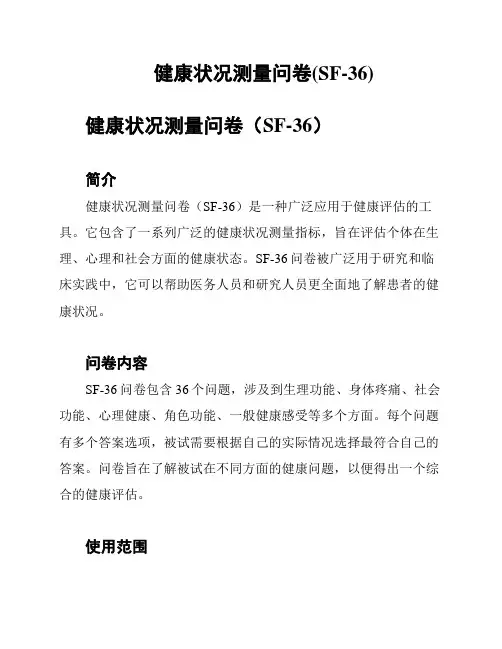
健康状况测量问卷(SF-36)健康状况测量问卷(SF-36)
简介
健康状况测量问卷(SF-36)是一种广泛应用于健康评估的工具。
它包含了一系列广泛的健康状况测量指标,旨在评估个体在生理、心理和社会方面的健康状态。
SF-36问卷被广泛用于研究和临床实践中,它可以帮助医务人员和研究人员更全面地了解患者的健康状况。
问卷内容
SF-36问卷包含36个问题,涉及到生理功能、身体疼痛、社会功能、心理健康、角色功能、一般健康感受等多个方面。
每个问题有多个答案选项,被试需要根据自己的实际情况选择最符合自己的答案。
问卷旨在了解被试在不同方面的健康问题,以便得出一个综合的健康评估。
使用范围
SF-36问卷适用于不同年龄段和不同健康状况的人群。
它可以用于评估患者在某一特定时间点的健康状况,也可以用于跟踪患者在一段时间内健康状态的变化。
SF-36问卷的应用领域广泛,包括临床医学研究、流行病学研究以及日常健康管理等方面。
它可以用于了解患者在不同健康问题下的生理和心理状态。
结论
健康状况测量问卷(SF-36)是一种常用的健康评估工具,可以帮助医务人员和研究人员更全面地了解患者的健康状况。
通过对36个问题的回答,SF-36问卷可以对被试的生理、心理和社会健康状态进行评估。
它的应用范围广泛,可以用于不同年龄段和不同健康状况的人群。
SF-36问卷的使用有助于改善临床实践和健康管理的决策制定。
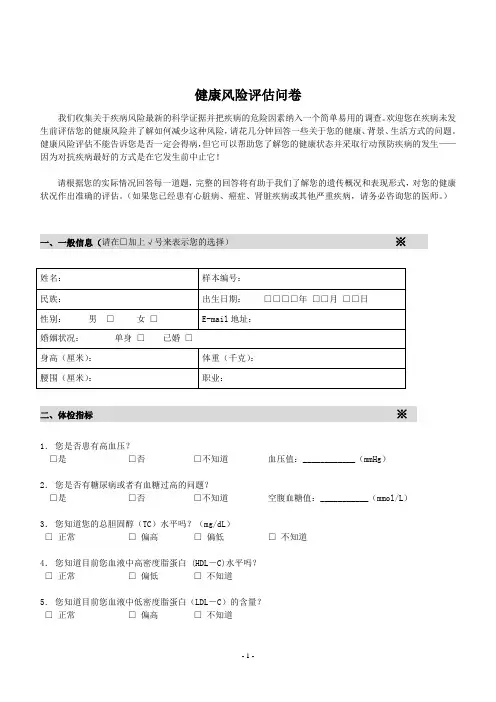
健康风险评估问卷我们收集关于疾病风险最新的科学证据并把疾病的危险因素纳入一个简单易用的调查。
欢迎您在疾病未发生前评估您的健康风险并了解如何减少这种风险,请花几分钟回答一些关于您的健康、背景、生活方式的问题。
健康风险评估不能告诉您是否一定会得病,但它可以帮助您了解您的健康状态并采取行动预防疾病的发生——因为对抗疾病最好的方式是在它发生前中止它!请根据您的实际情况回答每一道题,完整的回答将有助于我们了解您的遗传概况和表现形式,对您的健康状况作出准确的评估。
(如果您已经患有心脏病、癌症、肾脏疾病或其他严重疾病,请务必咨询您的医师。
)一、一般信息(请在□加上√号来表示您的选择)※二、体检指标※1.您是否患有高血压?□是□否□不知道血压值:____________(mmHg)2.您是否有糖尿病或者有血糖过高的问题?□是□否□不知道空腹血糖值:___________(mmol/L)3.您知道您的总胆固醇(TC)水平吗?(mg/dL)□正常□偏高□偏低□不知道4.您知道目前您血液中高密度脂蛋白 (HDL-C)水平吗?□正常□偏低□不知道5.您知道目前您血液中低密度脂蛋白(LDL-C)的含量?□正常□偏高□不知道6.其他体检指标:心电图:□异常□正常□不清楚说明: __________ ______________ 胸部X线:□异常□正常□不清楚说明:__________________ _______ 肝功能检查:□异常□正常□不清楚说明:_____________ ____________ CT检查:□异常□正常□不清楚说明:___________ ______________ 超声波检查:□异常□正常□不清楚说明:_____________ ____________ 乙肝表面抗原(HBsAg):□阴性□阳性□不清楚抗丙肝抗体(抗HCV):□阴性□阳性□不清楚幽门螺杆菌感染:□阴性□阳性□不清楚人类乳头瘤病毒感染:□阴性□阳性□不清楚EB病毒感染:□阴性□阳性□不清楚STD(性传染疾病)(包括疱疹,淋病,衣原体感染和HIV/AIDS):□是□否□不清楚说明:____________________________三、健康状况和家族史(如现在有下列情况请在方格加上√号)※1.如果您有以下情况发生?□您是否有慢性疼痛史?□您是否对感冒或流感易感且持续很长时间?□您是否患有鼻窦炎、关节炎等慢性疾病?□您是否有视力、听力减退现象?□您现在是否变得对酒精、香水和空气污染等过敏?□您是否有过药物过敏史?2.自我用药和处方用药情况您是否经常使用皮质激素等激素类药品(如:强的松、地塞米松等)是□否□您是否经常服用免疫抑制剂药物(如:环孢菌素)?是□否□您是否经常服用利尿降压药(如:速尿、氢氯噻嗪等)?是□否□您是否经常服用雌激素类药物(如:雌二醇和雌酮)?是□否□您是否长期使用抗抑郁、酸中和药(制酸药)及消炎等处方药物?是□否□您是否长期服用阿司匹林、扑热息痛、布洛芬、抗酸药、泻药及安眠药等?是□否□3.您或您家庭的成员(父母、兄弟、姐妹、祖父母)是否有下列病史?四、饮食习惯※1.您每天吃多少绿色新鲜蔬菜?例如:甘蓝、菠菜、椰菜、卷心菜、莴苣等(一份:4两蔬菜)□每天5~6份□每天3~4份□每天1~2份□很少或从来不吃2.您每天吃多少新鲜的水果?(一份:一个中等大小的苹果、香蕉和桔子等)□每天5~6份□每天3~4份□每天1~2份□很少或从来不吃3.您每天吃多少高胆固醇或高脂肪的食品?例如:肥肉、猪油、黄油、动物内脏、奶酪、油炸食品或鸡蛋(一份:为2两肉、或1个鸡蛋)□每天5~6份□每天3~4份□每天1~2份□很少或从来不吃4.您每天吃多少高纤维的食品?例如:全谷类制品(如小米、玉米、豆面、荞麦等粗粮)、新鲜水果或蔬菜(一份:相当于1两主食、或4两蔬菜、或4两水果)□每天5~6份□每天3~4份□每天1~2份□很少或从来不吃5.您每天吃多少腌制或熏烤食品?例如:酸菜、泡菜、腌青菜、霉菜、腊肉、烤肉等(一份:为2两肉、或2两腌菜)□每天5~6份□每天3~4份□每天1~2份□很少或从来不6.您每天吃多少奶油棒,烘烤食物或油炸食品?例如:薯条、油条、饼干,蛋糕,派等(一份:为2根油条、或1包薯条)□每天5~6份□每天3~4份□每天1~2份□很少或从来不吃7.您每天吃多少精制谷类?例如白面包、精白米、精制面条、马铃薯等(一份是指两三片面包,一小碗煮熟的谷类、米饭、面条。
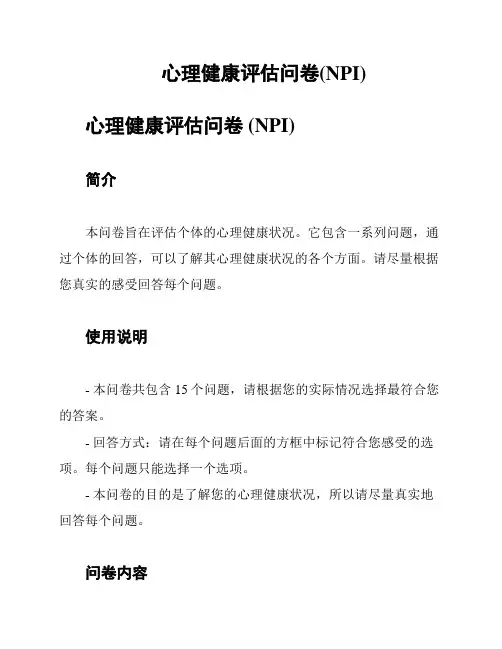
心理健康评估问卷(NPI)心理健康评估问卷 (NPI)简介本问卷旨在评估个体的心理健康状况。
它包含一系列问题,通过个体的回答,可以了解其心理健康状况的各个方面。
请尽量根据您真实的感受回答每个问题。
使用说明- 本问卷共包含15个问题,请根据您的实际情况选择最符合您的答案。
- 回答方式:请在每个问题后面的方框中标记符合您感受的选项。
每个问题只能选择一个选项。
- 本问卷的目的是了解您的心理健康状况,所以请尽量真实地回答每个问题。
问卷内容请在每个问题后面选择一个选项,符合您的感受。
1. 我感到自己无望,对未来没有希望。
- [ ] 从不- [ ] 偶尔- [ ] 经常- [ ] 总是2. 我感到无法享受生活中的乐趣。
- [ ] 从不- [ ] 偶尔- [ ] 经常- [ ] 总是3. 我感到疲惫不堪。
- [ ] 从不- [ ] 偶尔- [ ] 经常- [ ] 总是4. 我容易发脾气或愤怒。
- [ ] 从不- [ ] 偶尔- [ ] 经常- [ ] 总是5. 我感到难以集中注意力。
- [ ] 从不- [ ] 偶尔- [ ] 经常- [ ] 总是6. 我感到自己没有价值。
- [ ] 从不- [ ] 偶尔- [ ] 经常- [ ] 总是7. 我感到对事物失去了兴趣。
- [ ] 从不- [ ] 偶尔- [ ] 经常- [ ] 总是8. 我感到对决策变得困难。
- [ ] 从不- [ ] 偶尔- [ ] 经常- [ ] 总是9. 我感到紧张或焦虑。
- [ ] 从不- [ ] 偶尔- [ ] 经常- [ ] 总是10. 我感到压力很大。
- [ ] 从不- [ ] 偶尔- [ ] 经常- [ ] 总是11. 我感到害怕或恐惧。
- [ ] 从不- [ ] 偶尔- [ ] 经常- [ ] 总是12. 我感到身体不适或精力下降。
- [ ] 从不- [ ] 偶尔- [ ] 经常- [ ] 总是13. 我感到晚上睡眠不好。
- [ ] 从不- [ ] 偶尔- [ ] 经常- [ ] 总是14. 我对自己的表现感到失望。
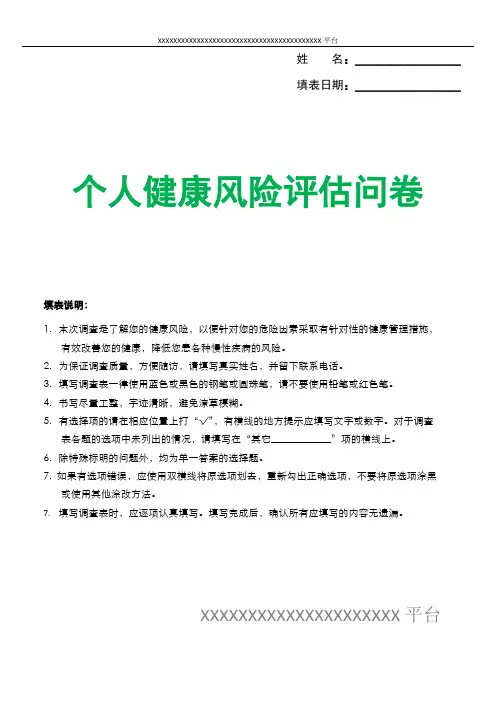
姓名:__________________填表日期:__________________ 个人健康风险评估问卷填表说明:1.本次调查是了解您的健康风险,以便针对您的危险因素采取有针对性的健康管理措施,有效改善您的健康,降低您患各种慢性疾病的风险。
2.为保证调查质量,方便随访,请填写真实姓名,并留下联系电话。
3.填写调查表一律使用蓝色或黑色的钢笔或圆珠笔,请不要使用铅笔或红色笔。
4.书写尽量工整,字迹清晰,避免潦草模糊。
5.有选择项的请在相应位置上打“√”,有横线的地方提示应填写文字或数字。
对于调查表各题的选项中未列出的情况,请填写在“其它____________”项的横线上。
6.除特殊标明的问题外,均为单一答案的选择题。
7. 如果有选项错误,应使用双横线将原选项划去,重新勾出正确选项,不要将原选项涂黑或使用其他涂改方法。
7.填写调查表时,应逐项认真填写。
填写完成后,确认所有应填写的内容无遗漏。
XXXXXXXXXXXXXXXXXXXXX平台健康风险评估调查问卷您好!欢迎您加入“个人健康风险评估”服务项目。
本项服务目的在于了解您的健康状况,评价健康风险,进而指导您获得健康的生活方式。
我们充分尊重个人信息隐私权,任何个人或机构未经您的许可或授权,均不能获得任何个人信息。
请您如实回答每一个问题,在符合您情况的选项上划“√”。
谢谢您的合作![01]基本信息[02]个人疾病史-(14)-01[03]疾病家族史[04]吸烟[05]膳食[06]运动[07]睡眠[08]心理状况[09]居住环境[10]体检信息。
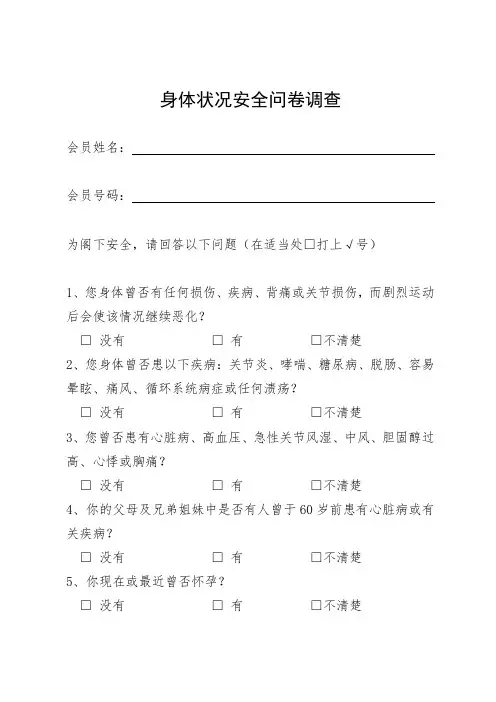
身体状况安全问卷调查
会员姓名:
会员号码:
为阁下安全,请回答以下问题(在适当处□打上√号)
1、您身体曾否有任何损伤、疾病、背痛或关节损伤,而剧烈运动后会使该情况继续恶化?
□没有□有□不清楚
2、您身体曾否患以下疾病:关节炎、哮喘、糖尿病、脱肠、容易晕眩、痛风、循环系统病症或任何溃疡?
□没有□有□不清楚
3、您曾否患有心脏病、高血压、急性关节风湿、中风、胆固醇过高、心悸或胸痛?
□没有□有□不清楚
4、你的父母及兄弟姐妹中是否有人曾于60岁前患有心脏病或有关疾病?
□没有□有□不清楚
5、你现在或最近曾否怀孕?
□没有□有□不清楚
6、你现在有否服用医生处方之药物?
□没有□有□不清楚7、你是否有任何其它情况导致您需要修改运动课程?□没有□有□不清楚8、你最近有否经常进行剧烈活动?如有者,是何种运动?
□没有□有□不清楚
签署
日期。
尊敬的参与者:您好!为了更好地了解您的心理状态、行为模式和人际关系,我们特此开展本次心理调查。
您的参与对我们研究具有重要意义,我们将严格保密您的个人信息。
请您根据自己的实际情况认真填写以下问卷,感谢您的支持与配合!一、基本信息1. 性别:(1)男(2)女(3)其他2. 年龄:()岁3. 学历:(1)小学及以下(2)初中(3)高中/中专(4)大专(5)本科(6)硕士及以上4. 职业:()行业5. 婚姻状况:(1)未婚(2)已婚(3)离异(4)丧偶二、心理状态评估6. 近期是否有焦虑、紧张、压抑等情绪?(1)经常(2)偶尔(3)很少(4)没有7. 您是否经常感到疲劳?(1)是(2)否8. 您是否经常感到睡眠质量差?(1)是(2)否9. 您是否经常感到头痛、胃痛等身体不适?(1)是(2)否10. 您是否经常感到心情低落?(1)是(2)否三、行为模式评估11. 您是否经常拖延做事?(1)是(2)否12. 您是否经常感到紧张、焦虑,导致工作效率低下?(1)是(2)否13. 您是否经常因人际关系问题而感到困扰?(1)是(2)否14. 您是否经常感到自卑、不自信?(1)是(2)否15. 您是否经常通过购物、暴饮暴食等方式来缓解情绪?(1)是(2)否四、人际关系评估16. 您与家人、朋友的相处关系如何?(1)非常好(2)较好(3)一般(4)较差(5)非常差17. 您在工作中与同事的相处关系如何?(1)非常好(2)较好(3)一般(4)较差(5)非常差18. 您是否经常感到孤独、无助?(1)是(2)否19. 您是否愿意向他人倾诉自己的烦恼?(1)是(2)否20. 您是否认为自己在人际关系中处于劣势?(1)是(2)否感谢您参与本次心理调查!您的宝贵意见将有助于我们更好地了解心理状态,为改善人们的生活质量提供有力支持。
祝您生活愉快!问卷填写说明:1. 请根据实际情况选择最符合您的选项。
2. 如有疑问,可随时联系我们的工作人员。
疫情期间身体健康状况调查问卷
为了了解在疫情期间个体的身体健康状况,我们邀请您填写以下调查问卷。
您的回答将对我们的研究和提供相关帮助具有重要意义。
请您如实回答以下问题。
基本信息
1. 姓名:
2. 年龄:
3. 性别:
4. 居住地区(城市/县):
健康状况
5. 您在疫情期间是否出现过以下症状(选择适用项):
- [ ] 发热
- [ ] 干咳
- [ ] 嗓子痛
- [ ] 呼吸困难
- [ ] 乏力
- [ ] 肌肉或关节痛
- [ ] 嗅觉或味觉减退
- [ ] 其他(请注明):
6. 您是否曾接触过被确诊为COVID-19患者或疑似病例的人?- [ ] 是
- [ ] 否
7. 您是否进行过新冠病毒核酸检测?
- [ ] 是
- [ ] 否
8. 如果您进行过新冠病毒核酸检测,请告知结果:__________
9. 您最近两周内是否有过到过疫情高风险区域旅行的经历?
- [ ] 是
- [ ] 否
10. 您是否已经接种过COVID-19疫苗?
- [ ] 是
- [ ] 否
11. 如果您已经接种过COVID-19疫苗,请告知接种厂家和日期:__________
12. 请告知您目前的健康状况及其他需要补充的信息:
__________
感谢您的参与!您的回答对我们非常重要。
如有其他相关信息需要提供,请在下方补充说明。
尊敬的参与者:您好!为了更好地了解公众对生理危害的认知程度以及生理危害对个人健康的影响,我们特此开展此次调查。
您的参与对我们非常重要,所有信息仅用于统计分析,我们将严格保密。
请您根据自己的实际情况认真填写以下问卷。
感谢您的支持与配合!一、基本信息1. 您的性别:(1)男(2)女(3)其他2. 您的年龄:(1)18岁以下(2)18-20岁(3)21-30岁(4)31-40岁(5)41-50岁(6)51-60岁(7)60岁以上3. 您的居住地:(1)城市(2)农村二、生理危害认知4. 您是否了解以下生理危害?(1)重金属中毒(2)农药残留(3)辐射污染(4)空气污染(5)水质污染(6)食品添加剂(7)其他(请说明):__________5. 您认为以下哪些生理危害对健康影响最大?(1)重金属中毒(2)农药残留(3)辐射污染(4)空气污染(5)水质污染(6)食品添加剂(7)其他(请说明):__________6. 您对以下生理危害的严重程度有何看法?(1)重金属中毒(2)农药残留(3)辐射污染(4)空气污染(5)水质污染(6)食品添加剂(7)其他(请说明):__________三、生理危害防护7. 您在日常生活中是否采取以下措施来预防生理危害?(1)购买有机食品(2)使用空气净化器(3)饮用过滤水(4)食用新鲜蔬菜水果(5)注意饮食卫生(6)其他(请说明):__________8. 您认为以下哪些措施最有效?(1)购买有机食品(2)使用空气净化器(3)饮用过滤水(4)食用新鲜蔬菜水果(5)注意饮食卫生(6)其他(请说明):__________9. 您是否了解以下生理危害防护知识?(1)重金属中毒防护(2)农药残留防护(3)辐射污染防护(4)空气污染防护(5)水质污染防护(6)食品添加剂防护(7)其他(请说明):__________ 10. 您认为以下哪些防护知识最实用?(1)重金属中毒防护(2)农药残留防护(3)辐射污染防护(4)空气污染防护(5)水质污染防护(6)食品添加剂防护(7)其他(请说明):__________四、其他11. 您对政府和社会各界在生理危害防治方面的努力有何评价?(1)非常满意(2)满意(3)一般(4)不满意(5)非常不满意12. 您对本次调查有何建议或意见?__________感谢您的参与!祝您身体健康,生活愉快!。
新冠疫情下大学生体育锻炼与心理健康情况的调查问卷亲爱的同学们,目前正处于冠状病毒大流行时期,我们设计了一份问卷,调查大家当前时期的状态,您的反馈可以更加有利于制定相关的防疫策略方针和运动锻炼方案。
再次感谢您的认真做答。
1.你的性别是男女2.你的年级是大一大二大三大四3.你所学专业属于文科理科术科(体音美等)4.你的家庭所属地是农村镇(非农业人口)或县城(或县级市)县级以上城市5.你是否为独生子女是否6.受新冠肺炎疫情影响被封闭管控在学校的时间是未封校<15天15〜30天30〜45天45天以上7.你进行体育锻炼的强度怎么样?轻微运动(如散步、做广播体操、打门球等)小强度的不太紧张的运动(如消遣娱乐性的打打排球、乒乓球、慢跑、打太极拳等中等强度的较激烈持久运动(如骑自行车、跑步、打乒乓球等)呼吸急促,出汗很多的大强度的,但并不持久的运动(如打羽毛球、篮球和足球等)呼吸急促,出汗很多的大强度、持久的运动(如赛跑、成套健美操练习、游泳等)8.你在进行上述强度体育活动时,一次多少分钟?10分钟以下10至20分钟21至30分钟31至59分钟60分钟以上9.你进行上述强度体育锻炼的次数?一个月3次或以下每周1或2次每周3至5次几乎每天10.关于互联网(电脑、手机等)使用情况的调查,请根据您近期实际情况选择。
非常不符合不符合符合非常符合1.我每天早上醒来,首先想到的就是上网或玩手机2.没有网络,我的生活毫无意义3.我只要有一段时间没有上网就会情绪低落4.我只要有一段时间没有上网,就会觉得自己好像错过了什么5.不管再累,上网时总觉得很有精神6.我发现自己上网的时间越来越长7.从上学期以来,平均而言我每周上网的时间增加了8.比起以前,我必须花费更多的时间上网才能感到满足9.其实每次我都只是想上网待一下子,但常常一待就是好久10.上网对我的身体造成了一定负面影响11.因为上网,我平时休闲活动时间减少了12.上网对我的学业和工作已造成一定的负面影响13.我因为上网减少了和身边朋友的互动14.我曾因为上网而腰酸背痛,或其他身体不适15.我曾不止一次因为上网而睡不到4小时16.我习惯减少睡眠时间,以便有更多的上网时间17.我曾因为熬夜上网而导致白天精神不好18.曾不止一次有人告诉我,我花太多时间在网络上11.关于情绪的调查,请选择现在或过去一周出现以下情况或感受的频度。
尊敬的受访者:您好!为了更好地了解您对平衡健康的认知、态度以及行为习惯,我们特设计此份调查问卷。
您的宝贵意见将有助于我们改进服务,提高健康素养。
本问卷采取匿名方式,所有信息仅用于统计分析,请您放心填写。
感谢您的参与和支持!一、基本信息1. 您的性别:- 男- 女- 其他2. 您的年龄:- 18岁以下- 18-25岁- 26-35岁- 36-45岁- 46-55岁- 56岁以上3. 您的职业:- 学生- 企事业单位员工- 自由职业者- 退休人员- 其他4. 您的月收入:- 3000元以下- 3000-5000元- 5000-8000元- 8000-12000元- 12000元以上二、平衡健康认知5. 您是否了解平衡健康的概念?- 是- 否6. 您认为平衡健康包括哪些方面?- 心理健康- 生理健康- 社会健康- 其他(请注明)7. 您认为平衡健康的重要性如何?- 非常重要- 重要- 一般- 不重要- 完全不重要三、平衡健康态度8. 您是否认同以下观点?- 平衡健康是提高生活质量的基石 - 平衡健康对工作、学习有积极影响- 平衡健康有助于人际关系和谐(请在以下选项中选择)- 完全同意- 同意- 不确定- 不同意- 完全不同意9. 您认为以下哪些因素对平衡健康有负面影响? - 工作压力- 生活节奏快- 缺乏运动- 不良饮食习惯- 其他(请注明)四、平衡健康行为10. 您平均每周运动几次?- 0次- 1-2次- 3-4次- 5次以上11. 您的运动方式主要是?- 有氧运动(如跑步、游泳等)- 无氧运动(如举重、健身等)- 休闲运动(如瑜伽、太极等)- 其他(请注明)12. 您是否遵循健康饮食原则?- 是- 否13. 您每天摄入的蔬菜和水果量是否充足?- 是- 否14. 您是否经常熬夜?- 是- 否15. 您是否吸烟或饮酒?- 是- 否五、其他建议16. 您对平衡健康有哪些建议或想法?- (请在此处填写)感谢您抽出宝贵时间填写本问卷!祝您身体健康、生活愉快!。
健康状况调查问卷(Hsq)编号_________ 姓名_________ 性别_________ 年龄_________下面的问题是询问您对自己健康状况的看法、您的感觉如何以及您进行日常活动的能力如何。
如果您没有把握如何回答问题,尽量选择一个最好的答案。
1.总体来讲,您的健康状况是:1)非常好2)很好3)好4)一般5)差6)放弃2.跟一年前相比,您觉得您现在的健康状况是:1)比一年前好多了 2)比一年前好一些 3)和一年前差不多4)比一年前差一些 5)比一年前差多了 6)放弃以下这些问题都与日常活动有关。
您的健康状况是否限制了这些活动?如果有限制,程度如何?3.重体力活动能够(如跑步、举重物、激烈运动等)1)有很多限制 2)有一点限制 3)根本没限制4)放弃4.适度活动(如移桌子、扫地、做操等)1)有很多限制 2)有一点限制 3)根本没限制4)放弃5.手提日杂用品(如买菜、购物等)1)有很多限制 2)有一点限制 3)根本没限制4)放弃6.上几层楼梯1)有很多限制 2)有一点限制 3)根本没限制4)放弃7.上一层楼梯1)有很多限制 2)有一点限制 3)根本没限制4)放弃8.弯腰、曲膝、下蹲1)有很多限制 2)有一点限制 3)根本没限制4)放弃9.步行1500米左右的路程1)有很多限制 2)有一点限制 3)根本没限制4)放弃10.步行800米左右的路程1)有很多限制 2)有一点限制 3)根本没限制4)放弃11.步行约100米的路程1)有很多限制 2)有一点限制 3)根本没限制4)放弃12.自己洗澡、穿衣1)有很多限制 2)有一点限制 3)根本没限制4)放弃在过去四个星期里,您的工作和日常活动有没有因为身体健康的原因而出现以下这些问题?13.减少了工作或其他活动的时间1)有 2)没有 3)放弃14.本来想要做的事情只能完成一部分1)有 2)没有 3)放弃15.想要做的工作或活动的种类受到限制1)有 2)没有 3)放弃16.完成工作或其他活动有困难(比如,需要额外的)1)有 2)没有 3)放弃在过去四个星期里,您的工作和日常活动有没有因为情绪(如感到消沉或者忧虑)而出现以下问题?17.减少了工作或其他活动的时间1)有 2)没有 3)放弃18.本来想要做的事情只能完成一部分1)有 2)没有 3)放弃19.做工作或者其它活动能够不如平时仔细1)有 2)没有 3)放弃20.在过去四个星期里,您的身体健康或情绪不好在多大程度上影响了您与家人、朋友、邻居或集体的正常社交活动?1)根本没有影响 2)很少有影响 3)有中度影响4)有较大影响 5)有极大影响 6)放弃21.在过去四个星期里,您有身体上的疼痛吗?1)根根本没有疼痛 2)很有很轻微疼痛 3)有有轻微疼痛4)有有中度疼痛 5)有有严重疼痛 6)放有很严重的疼痛7)放弃22.在过去四个星期里,身体上的疼痛影响您的正常工作吗(包括上班工作和家务活动)?根本没有影响1)根本没有影响 2)有一点影响 3)有中度影响4)有较大影响 5)有极大影响 6)放弃有以下这些问题有关过去一个月里您的感觉如何以及您的情况如何。
International University Bremen & Freie Universität BerlinRisk and Health Behaviors Documentation of the Scales of the Research Project:“Risk Appraisal Consequences in Korea” (RACK)(Second Edition)Britta Renner & Ralf SchwarzerIn cooperation withSunkyo Kwon, Youlia Spivak, and Martina Panzerwww.gesundheitsrisiko.deTABLE OF CONTENTS1PREFACE (1)2GENERAL DESCRIPTION OF GROUP OF PARTICIPANTS (2)2.1Age and sex (2)2.2Socioeconomic status (2)2.2.1 Education (2)2.2.2 Occupation (2)2.2.3 Marital status (3)2.2.4 Social standing (3)2.2.5 Financial scope (3)2.2.6 Household income (3)3HEALTH AND ILLNESS (4)3.1Illness status (4)3.2Medication (5)3.3Current dietary status (5)3.4Self ratings of health (5)3.4.1 Self rated absolute health status (5)3.4.2 Self rated comparative health status (5)3.4.3 Self rated health status transition (6)3.5Subjective assessment of current cholesterol und blood pressure values (7)3.6Previous screening behavior and screening results (7)3.6.1 Regularity of measurement (7)3.6.2 Point of last measurement (7)3.6.3 Categorical value of the previous physiological readings (8)3.6.4 Numerical value of the previous physiological readings (8)4HEALTH BEHAVIORS (9)4.1Nutrition style (9)4.2Exercise (10)4.2.1 Duration and type of exercise (10)4.2.2 Regularity of exercise activities (10)4.2.3 Intensity of exercise activities (11)4.3Tobacco consumption (11)4.3.1 Smoker status (11)4.3.2 Beginning of smoking (11)4.3.3 Duration of smoking abstinence (11)4.3.4 Number of tobacco products consumed per day (11)4.3.5 Smoking interruptions (12)4.4Alcohol consumption (12)4.4.1 Regularity of alcohol consumption (12)4.4.2 Beginning of regular alcohol consumption (12)4.4.3 Frequency and amount of alcohol consumption (12)4.5Frequency of past behavior change attempts (13)4.5.1 Change of nutrition habits (13)4.5.2 Physical exercise (13)4.5.3 Smoking abstinence (13)4.5.4 Limiting alcohol consumption (13)5HEALTH- AND ILLNESS-RELATED COGNITIONS (14)5.1Risk perception (14)5.1.1 Absolute risk perception for the self (14)5.1.2 Absolute risk perception for peers (14)5.1.3 Relative vulnerability (15)5.2Perceived severity (16)5.2.1 General severity assessment (16)5.2.2 Individual severity (16)5.2.3 Preceived threat to one’s own health (17)5.3Perceived Control (17)5.3.1 Perceived behavior-related control (17)5.4Illness among acquaintances (18)5.5Intentions (19)5.6Planning behavior changes (19)5.6.1 Planning to change nutrition habits (19)5.6.2 Planning new exercise activities (20)5.6.3 Planning smoking withdrawal (21)5.6.4 Planning to limit alcohol consumption (21)5.7Outcome expectancies of behavior change (23)5.7.1 Outcome expectancies – change of nutrition habits (23)5.7.2 Exercise outcome expectancies (23)5.7.3 Outcome expectancies – quitting smoking (24)5.7.4 Outcome expectancies – reduction of alcohol consumption (25)5.8Behavior change self-efficacy (26)5.8.1 Self-efficacy – change of nutrition habits (26)5.8.2 Exercise self-efficacy (27)5.8.3 Self-efficacy – quitting smoking (29)5.8.4 Self-efficacy – limitation of alcohol consumption (29)5.9Health Locus of Control (30)Table of contents III6PERSONALITY DISPOSITIONS (32)6.1General self-efficacy (32)6.2Self-esteem scale (33)7CURRENT MOOD (34)7.1Current mood (34)7.2Current Happiness (34)7.3Current condition/form (35)8KNOWLEDGE (35)8.1Berlin cholesterol and blood pressure knowledge test (BCBT) (35)8.2Perceived knowledge about blood pressure and cholesterol (38)8.2.1 Expected number of correctly answered questions (38)8.2.2 Perceived confidence (38)8.2.3 Expected average number of correctly answered questions (38)8.2.4 Contentment with the individual level of knowledge (39)9PROCESS MODEL OF HEALTH BEHAVIOR (40)9.1Stage model of health awareness and behavior(SHAB) (40)10MEASUREMENT AND MEASURED VALUES (41)10.1Recalled measures (41)10.2Perceived accuracy and representativeness of the measures (42)10.2.1 Measurement accuracy of the current measurement (42)10.2.2 General measurement accuracy (42)10.2.3 Representativeness of the current measurement (42)10.3Expected physiological values for the first and second measuring times (43)10.3.1 Expected values for the first measurement (43)10.3.2 Expected values for the second measurement (43)10.4Perceived discrepancy of physiological values (44)10.4.1 Perceived discrepancy between real and measured values (44)10.4.2 Valence of perceived discrepancy between real and measured readings (45)10.5Recall of the expected values (45)10.6Processing depth regarding the results (46)11COGNITIONS REGARDING RISK STATUS AND ITS IMPLICATION FOR THE FUTURE (47)11.1Progression (47)IV Tablecontentsof11.2Base rate (47)11.2.1 Base rate of risk factors for cardiovascular disease (47)11.2.2 Base rate of cardiovascular disease (47)11.3Current concern (48)11.4Probability of lowering risk status (48)11.5Perceived barriers of protective actions (49)11.6 Subjective pressure to change (49)Preface 11 PrefaceThe current documentation serves to make psychometric scales available to a broader international public in order to disseminate the research materials and to stimulate joint cross-cultural studies on health cognitions and health behaviors.This line of research started in 1994 with a major field project launched in Berlin, Germany, funded by the German Research Foundation (DFG), under the title “Berlin Risk Appraisal and Health Motivation Study” (BRAHMS). Results from this project have been published in various sources (e.g., Renner, 2004; 2003; Renner & Schwarzer, 2003; Schwarzer & Renner, 2000; Renner, Hahn, & Schwarzer, 1996; Renner, Knoll, & Schwarzer, 2000).Currently, a follow-up project is being conducted in South Korea, also funded by DFG. The Korean psychometric instruments are to a in most cases comparable to the German version in order to guarantee a solid basis for cross-cultural comparison. However, some aspects have been improved and others have been added.We do hope that parts of this English version will be adopted for use in English-speaking samples, and we would be grateful for any feedback concerning the proper wording of the test items.Bremen, January 2005-01-10Britta Renner and Ralf SchwarzerReferences:Renner, B. (2003). Hindsight bias after receiving self-relevant health risk information: A motivational perspective. Memory, 11(4-5), 455-472.Renner, B. (2004). Biased reasoning. Adaptive responses to health risk feedback. Personality & Social Psychology Bulletin, 30(3), 384-396.Renner, B., Hahn, A., & Schwarzer, R. (1996). Risiko und Gesundheitsverhalten.Skalendokumentation Berlin: Freie Universität.Renner, B., Knoll, N., & Schwarzer, R. (2000). Age and body weight make a difference in optimistic health beliefs and nutrition behaviors. International Journal of Behavioral Medicine, 7(2), 143-159.Renner, B., & Schwarzer, R. (2003). Social-cognitive Factors in health behavior change. In J.Suls & K. A. Wallston: Social psychological foundations of health and illness (pp. 169-196). Malden, MA: Blackwell.Schwarzer, R., & Renner, B. (2000). Social-cognitive predictors of health behavior: Action self-efficacy and coping self-efficacy. Health Psychology, 19(5), 487-495.2Generalof group of participantsdescription 2 General description of group of participants2.1 Age and sexDate of birthAge Year Month DaySexmale female2.2 Socioeconomic status2.2.1 EducationYour highest degree:Did not graduate from high school 1Middle school 2Dropped out of vocational training 3High school or dropped out of college 4Technical school 5College/university 6Graduate school and more 72.2.2 OccupationWhat is your current occupation/ was your last one?High school or college student 1Housewife 2Unemployed 34Blue-collar worker (farmer, construction worker, factoryworker)Skilled worker (carpenter, hairdresser, electrician ) 56Service or sales domain (tradesman, insurance agent,policeman)White collar worker (business employee) 7Manager, entrepreneur 89Professional who does freelance work (physician, professor,lawyer, clergyman etc.)Others______________________________ 10If you are currently unemployed or retired (does not apply to students and housewives), pleaseindicate your main occupation(s) in the last five years or earlier:__________________________General description of group of participants 3 2.2.3 Marital statussingle 1married or living together 2widowed 3remarried 4divorced or separated 52.2.4 Social standingHow would you describe your social standing?lower class 1lower middle class 2middle class 3upper middle class 4upper class 52.2.5 Financial scopeHow would you describe your financial scope?much above average 1above average 2average 3below average 4much below average 52.2.6 Household incomeHow high is your household income?500 000 won or less 1510 000– 1 500 000won 21 510 000 – 3 000 000 won 33 010 000 won or more 4Health behaviors 4 3 Health and illness3.1 Illness statusIf you have or had one of the diseases listed below, please indicate additionally whether you underwent medical treatment for it in the last six months.Never had it Don’t haveit anymoreSufferingfrom itnowReceivedmedicaltreatment for itin the last 6monthscirculatory disorder of the heart 1 2 3 4 heart attack 1 2 3 4 cardiac insufficiency 1 2 3 4 stroke 1 2 3 4 circulatory disorder of the legs 1 2 3 4 hypertension 1 2 3 4 elevated cholesterol level (elevated bloodlipids)1 2 3 4 too low blood pressure 1 2 3 4 acute or chronic hepatitis, fatty liver 1 2 3 4 cirrhosis of the liver 1 2 3 4 biliary disease 1 2 3 4 diabetes 1 2 3 4 high overweight, obesity 1 2 3 4 gout, elevated uric acid 1 2 3 4 chronic bronchitis 1 2 3 4 thyroid disease 1 2 3 4 kidney disease 1 2 3 4 Other severe diseases, namely:1. ______________________________________________________________ 12. ______________________________________________________________ 13.2 MedicationDo you regularly take medicine... yes no ... to lower your blood pressure? 1 2... to lower your cholesterol/ blood lipids? 1 2... for your heart? 1 2... against diabetes? 1 2... for sedation? 1 2... against sleep disorders? 1 2... for contraception (the pill)? 1 2... for circulation/ to raise your blood pressure? 1 2... against other ailments? 1 2Do you practice..…Traditional Chinese Medicine? 1 23.3 Current dietary statusDo you follow a diet? 1 yes 2 noIf so, has a doctor prescribed it to you? 1 yes 2 noWhat kind of diet are you on?___________________________________________________What is the reason for your diet?_________________________________________________3.4 Self ratings of health3.4.1 Self rated absolute health statusIn general, how would you say your health is?1 2 3 4 5poor fair good very good excellent3.4.2 Self rated comparative health statusCompared to other persons of my sex and age, my current health is...1 2 3 4 5much below average below average average above average much aboveaverageAdopted from:Weinstein, N. D. (1987).Unrealistic optimism about susceptibility to health problems: Conclusions from a community-wide sample. Journal of Behavioral Medicine, 10(5), 481-500.3.4.3 Self rated health status transitionCompared to five years ago, my health in general now is…1 2 3 4 5much worse worse same better much betterCompared to my best health status ever, my health in general now is…1 2 3 4 5much worse worse same better much betterCompared to the best health status I can (still) reach, my health in general now is…1 2 3 4 5much worse worse same better much betterHas your health changed considerably in the last 12 months?1 2 3 4 5not at all not much somewhat much extremelyHow much is your everyday life affected by your health?1 2 3 4 5not at all not much somewhat much extremely3.5 Subjective assessment of current cholesterol und blood pressure valuesWhat do you think how high your cholesterol level is?My current cholesterol level is...1 2 3 4 5 6 7extremelylow low somewhatlownormal somewhathighhigh extremelyhighWhat do you think how high your blood pressure is?My current blood pressure is...1 2 3 4 5 6 7extremelylow low somewhatlownormal somewhathighhigh extremelyhigh3.6 Previous screening behavior and screening results3.6.1 Regularity of measurementDo you have your cholesterol level taken on aregular basis?1 yes2 no Do you have your blood pressure taken on a regularbasis?1 yes2 no3.6.2 Point of last measurementWhen did you last have your cholesterol level taken?Within the last 4 weeks 1 More than 4 weeks ago, but within the last 12 months 2 More than a year ago 3 Never 4When did you last have your blood pressure taken?Within the last 4 weeks 1 More than 4 weeks ago, but within the last 12 months 2 More than a year ago 3 Never 43.6.3 Categorical value of the previous physiological readingsHow was your last reading?My cholesterol level was...1 2 3 4 5 6 7extremelylow low somewhatlownormal somewhathighhigh extremelyhighHow was your last reading?My blood pressure was...1 2 3 4 5 6 7extremelylow low somewhatlownormal somewhathighhigh extremelyhigh3.6.4 Numerical value of the previous physiological readingsHow high was your...cholesterol level? ____________mg/dl don’t remember 1How high was your...systolic blood pressure? ____________mmHg don’t remember 1 diastolic blood pressure? ____________mmHg don’t remember 14 Health behaviors4.1 Nutrition styleSome statements about your nutrition habits in general:How much does each statement apply to you?Not at allBarely true Mostly true Exactly truetrueI am a vegetarian. 1 2 3 4When I eat cake or chocolate, I only eat1 2 3 4 little of it.I pay regard to eating little fat. 1 2 3 4I take vitamin supplements regularly. 1 2 3 4I usually eat fresh food. 1 2 3 4 When I drink milk or eat milk products, Ichoose low-fat products (e.g. low-fat1 2 3 4 milk).I often eat eggs (e.g. scrambled, boiled,fried). 1 2 3 4I am aware of the amount of calories inmy food. 1 2 3 4I drink soft drinks without sugar. 1 2 3 4I don’t eat fast food. 1 2 3 4I eat well-balanced food. 1 2 3 4I only eat low-salt food. 1 2 3 4I avoid cholesterol-rich food. 1 2 3 4I deliberately eat many vitamins. 1 2 3 4I prefer low-fat meat. 1 2 3 4I almost always add more salt to my food. 1 2 3 4I eat a lot of pork and beef. 1 2 3 4 To sweeten food, I use sweetener. 1 2 3 4I always remove the visible fat from myfood (e.g. from steaks or belly of pork). 1 2 3 44.2 Exercise4.2.1 Duration and type of exerciseHow often do you usually carry out the following physical activities ?(almost) every day 3-4 times a week once a week 1-3 times a monthless ornever Bicycling (also exercise bike) 1 2 3 4 5 Walking, hiking1 2 3 4 5 Calisthenics, gymnastics, aerobics, dancing 1 2 3 4 5 Endurance sports (swimming, running, jogging,rowing, etc.)1 2 3 4 5 Bodybuilding (weight training, weightlifting etc.) 1 2 3 4 5 Martial arts (karate, judo, taekwondo, aikido, kendo, kickboxing, boxing, etc.)1 2 3 4 5 Sport games (baseball, soccer, volleyball, tennis, handball, basketball, squash, badminton, etc.) 12345How much time do you spend on the above mentioned activities?________________hours per week. 4.2.2 Regularity of exercise activitiesHave you been exercising on a regular basis during the last year ? 1 no 2 yes, with longer interruptions 3 yes, with short interruptions 4 yes, without interruption4.2.3 Intensity of exercise activitiesDo you exercise during the week at least three times or more often for 30 minutes, to the extent of sweating and being out of breath?1 y es If so: Is it easy for you to exercise in spite of daily routines?1easy 2h ard2 no If not: Have you at least tried to begin to exercise?1yes 2n oAdopted from Lippke, S. & Ziegelmann, J. P. (2004). Understanding and modeling health behavior: The Multi-Stage Model of Health Behavior Change. Manuscript submitted for publication.4.3 Tobacco consumption4.3.1 Smoker statusAre you a...regular smoker?1occasional smoker?2ex-smoker (don’t smoke anymore, but used to)?34 non-smoker (don’t smoke and never did)?4.3.2 Beginning of smokingHow old were you when you began to smoke (even if only a small amount)?old____________years4.3.3 Duration of smoking abstinenceIf you don’t smoke anymore: How many years/ months ago did you quite?____________years ____________months4.3.4 Number of tobacco products consumed per dayHow much do or did you usually smoke per day?________cigarettes a day _________small cigars or cigars a day________pipes a day 1I don’t/ did not smoke every day.4.3.5 Smoking interruptionsHave you ever quit smoking for a longer period of time?1 no2 yes How long were you abstinent? ________years________months4.4 Alcohol consumption4.4.1 Regularity of alcohol consumptionDo you drink alcohol on a regular basis (irrespective of amount of alcohol consumed)1 no2yes4.4.2 Beginning of regular alcohol consumption•How old were you when you began to drink on a regular basis?_________ years old.4.4.3 Frequency and amount of alcohol consumptionHow often do you drink the following alcoholic beverages?Alcoholic beverage daily6-4times aweek3-2times aweekonce aweek1-3times amonthveryseldom,almostneveramount of alcoholconsumed on oneoccasionRice wine 1 23 4 5 6Rice wine glass(200ml)traditional Korean liqueur, Ginsengschnaps 1 234 5 6Glass (200ml)Suju 1 234 5 6Sujuglass (30ml) Beer 1 234 5 6Glass (200ml) Western spirits 1 234 5 6Glass (30ml) Asian spirits 1 234 5 6Glass (30ml)4.5 Frequency of past behavior change attempts4.5.1 Change of nutrition habitsHave you ever tried to change your nutrition habits (to eat low-fat or low-salt food)? 1 no 2 yes ⇒ If yes, how often? ________ times4.5.2 Physical exerciseHave you ever tried to resume exercising?1 no2 yes ⇒ If yes, how often? ________ times4.5.3 Smoking abstinenceHave you ever tried to quit smoking?1 no2 yes ⇒ If yes, how often? ________ times4.5.4 Limiting alcohol consumptionHave you ever tried to limit your consumption of alcoholic beverages?1 no2 yes ⇒ If yes, how often? ________ timesPartly adopted from Bagozzi, R. P. & Warshaw, P. R. (1990). Trying to consume. Journal of Consumer Research, 18, 127-140.14Health- and illness-related cognitions 5 Health- and illness-related cognitions5.1 Risk perception5.1.1 Absolute risk perception for the selfHow likely is it you will have a sometime in your life...very unlikely moderatelyvery likelylikely... a high cholesterol level?1 2 3 4 5 6 7... a heart attack?1 2 3 4 5 6 7... a high blood pressure?1 2 3 4 5 6 7... a stroke?1 2 3 4 5 6 7... a cardiovascular disease?1 2 3 4 5 6 7 5.1.2 Absolute risk perception for peersHow likely is it that an average person of your sex and age will have sometime in her/his life …very unlikely moderatelyvery likelylikely... a high cholesterol level?1 2 3 4 5 6 7... a heart attack?1 2 3 4 5 6 7... a high blood pressure?1 2 3 4 5 6 7... a stroke?1 2 3 4 5 6 7... a cardiovascular disease?1 2 3 4 5 6 7Adopted from Perloff, L. S., & Fetzer, B. K. (1986). Self-other judgments and perceived vulnerability to victimization. Journal of Personality & Social Psychology, 50(3), 502-510.5.1.3 Relative vulnerabilityCompared to an average person of my sex and age my chances of getting...... an elevated cholesterol level are1 2 3 4 5 6 7much below averagebelowaveragea littlebelowaverageaveragea littleaboveaverageaboveaveragemuch aboveaverage... a heart attack are1 2 3 4 5 6 7much below averagebelowaveragea littlebelowaverageaveragea littleaboveaverageaboveaveragemuch aboveaverage... an elevated blood pressure are1 2 3 4 5 6 7much below averagebelowaveragea littlebelowaverageaveragea littleaboveaverageaboveaveragemuch aboveaverage... a cardiovascular disease are1 2 3 4 5 6 7much below averagebelowaveragea littlebelowaverageaveragea littleaboveaverageaboveaveragemuch aboveaverageAdopted from Weinstein, N. D. (1987). Unrealistic optimism about susceptibility to health problems: Conclusions from a community-wide sample Journal of Behavioral Medicine, 10(5), 481-500.5.2 Perceived severity5.2.1 General severity assessmentHow severe (serious) are the following health-related problems if they aren’t medicated or remain undetected?Not severe atall (can be ignored)Moderatelysevere(as if someonewould have the flu)Very severe(life threatening)high cholesterollevel 1 2 3 4 5 6 7 heart attack 1 2 3 4 5 6 7high blood pressure 1 2 3 4 5 6 7stroke 1 2 3 4 5 6 7 cardiovasculardisease 1 2 3 4 5 6 7 Adopted from Ditto, P. H., Jemmott, J. B., & Darley, J. M. (1988). Appraising the threat of illnes: A mental representational approach. Health Psychology, 7(2), 183-201.5.2.2 Individual severityHow serious a threat to your health is your cholesterol?Not serious (can be ignored)Moderately serious(as if someone would have the flu)Very serious(life threatening)1 2 3 4 5 6 7 How serious a threat to your health is your blood pressure?Not serious (can be ignored)Moderately serious(as if someone would have the flu)Very serious(life threatening)1 2 3 4 5 6 75.2.3 Preceived threat to one’s own healthHow threatening is your cholesterol test result for your health?Not at all threatening RelativelythreateningVerythreatening1 2 3 4 5 6 7 How threatening is your blood pressure test result for your health?Not at all threatening RelativelythreateningVerythreatening1 2 3 4 5 6 7 5.3 Perceived Control5.3.1 Perceived behavior-related controlTo what extent can the onset of the following health problems be influenced by your behavior?The influence of my behavior on the onset of… extremely small Small medium high extremelyhigh... high cholesterol level is 1 2 3 4 5 ... a heart attack is 1 2 3 4 5 ... high blood pressure is 1 2 3 4 5 ... a stroke is 1 2 3 4 5 ... a cardiovascular disease is 1 2 3 4 55.4 Illness among acquaintancesDo either you, or someone you know, have or had one of the following health problems?no one 1 person 2 persons3-4persons5-7p ersons8 ormorepersons...high cholesterol level 1 2 3 4 5 6 ...heart attack 1 2 3 4 5 6 ...elevated blood pressure 1 2 3 4 5 6 ...stroke 1 2 3 4 5 6 ...cardiovascular disease 1 2 3 4 5 6Do either you, or someone you know, have or had one of the following health problems? Indicate your relationship to the person(s).Parents or siblingsOtherrelativesFriends oracquaintances...elevated cholesterol level1 2 3...heart attack1 2 3...cardiovascular disease (except heart attack or stroke)1 2 3Please explain the overlaps.If you don’t have somebody you know, write 01:_______________________________________Adopted from Weinstein, N. D. (1987). Unrealistic optimism about susceptibility to health problems: Conclusions from a community-wide sample. Journal of Behavioral Medicine, 10(5), 481-500.5.5 IntentionsWhich intentions do you have for the next weeks and months?I intend to...Don’tintend at all Strongly intend...live a healthier life.1 2 3 4 5 6 7 ...eat as healthy as possible.1 2 3 4 5 6 7 ... eat as little fat as possible (i.e.avoid fatty meat, cheese, etc.) 1 2 3 4 5 6 7 ...do more for my health.1 2 3 4 5 6 7 ...quit smoking.1 2 3 4 5 6 7 ...eat low-salt food.1 2 3 4 5 6 7 ...drink less alcohol.1 2 3 4 5 6 7 ...participate in a medicalexamination for early detection ofcardiovascular diseases.1 2 3 4 5 6 7 ...exercise regularly (at least oncea week). 1 2 3 4 5 6 7 ...lose weight.1 2 3 4 5 6 7 5.6 Planning behavior changes5.6.1 Planning to change nutrition habits5.6.1.1 Action PlanningMost people would like to further improve their nutrition by taking in less salt and fat. How about you?I already have concrete plans...Not at alltrueBarely true Mostly true Exactly true how to change my nutrition habits. 1 2 3 4 when to change my nutrition habits. 1 2 3 45.6.1.2 Coping PlanningMost people would like to further improve their nutrition habits by taking in less salt and fat. How about you?I already have concrete plans...Barely true Mostly true Exactly trueNot at alltruewhen to especially watch out in order tomaintain my new nutrition habits. 1 2 3 4 what to do in difficult situations in orderto stick to my intentions. 1 2 3 4 how to deal with relapses 1 2 3 45.6.2 Planning new exercise activities5.6.2.1 Action PlanningDo you already have concrete plans with regard to exercising?I already have concrete plans...Barely true Mostly true Exactly trueNot at alltrue...when to exercise. 1 2 3 4 ...where to exercise. 1 2 3 4 ...how to exercise. 1 2 3 4...how often to exercise.1 2 3 4 ...with whom to exercise. 1 2 3 45.6.2.2 Coping PlanningDo you already have concrete plans for your new exercise schedule (habits)?I already have concrete plans...Barely true Mostly true Exactly trueNot at alltrue...what to do if something intervenes. 1 2 3 4 ...what to do if I miss an exercise session. 1 2 3 4 …what to do in difficult situations in1 2 3 4 order to stick to my intentions.…when to especially watch out in order1 2 3 4to stay committed.5.6.3 Planning smoking withdrawal5.6.3.1 Action PlanningMost people want to quit smoking. How about you?I already have concrete plans...Not at allBarely true Mostly true Exactly truetrue...when to quit smoking. 1 2 3 4 ...how to quit smoking. 1 2 3 4 5.6.3.2 Coping PlanningMost people want to quit smoking. How about you?I already have concrete plans...Not at allBarely true Mostly true Exactly truetrue...how to deal with relapses into my oldhabits. 1 2 3 4 ...what to do in difficult situations to stickto my intentions. 1 2 3 4 ...when to especially watch out in ordernot to reach again for a cigarette. 1 2 3 4 5.6.4 Planning to limit alcohol consumption5.6.4.1 Action PlanningDo you already have concrete plans to reduce your alcohol consumption?I already have concrete plans...Not at allBarely true Mostly true Exactly truetrue...when to reduce alcohol consumption. 1 2 3 4...where, i.e. in which situations (at home,1 2 3 4at parties) to reduce alcohol consumption....how to reduce alcohol consumption. 1 2 3 4。